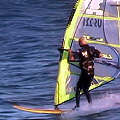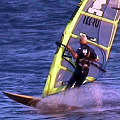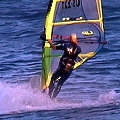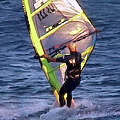Standard Jibe
There are important milestones in the progression of almost every sport -- doorways really -- that lead you to another relationship with the activity itself. For almost every windsurfer, learning to jibe is a real big event! There should be a ritual of some sort -- maybe we all gather around and chant: Uga-Jiba.. Uga-Jiba.. Uga-Jiba.. and then toss the blessed mate into the water where this important act was first performed. Naked of course! Which is another reason to get more woman into windsurfing. A little dramatic for sure but one can not attend a windsurfing party and proudly admit they do not even know how to jibe. So, for all those party animals yearning to get out of the house and party with the big boys ...












Rider: Royn Bartholdi
Steps
 1)
Unhook, and bear off wind with good speed, but not necessarily world record speed. Keep your eyes forward in the direction you are sailing. Keep the off the rails to maintain speed.
1)
Unhook, and bear off wind with good speed, but not necessarily world record speed. Keep your eyes forward in the direction you are sailing. Keep the off the rails to maintain speed.  2)
Take your back foot out of the strap and place it in front of the back strap on the centreline of the board.
2)
Take your back foot out of the strap and place it in front of the back strap on the centreline of the board.  3)
Slowly transfer your weight to the inside rail of of the board by bending your knees and pressuring the back foot. Keep sheeting in with the back hand until the sail feels like it has no power and you are heading straight downwind.
3)
Slowly transfer your weight to the inside rail of of the board by bending your knees and pressuring the back foot. Keep sheeting in with the back hand until the sail feels like it has no power and you are heading straight downwind.  4)
Keep the rail pressured as you pass to the other direction.
4)
Keep the rail pressured as you pass to the other direction.  5)
Release the pressure with the back hand (sheeting out) and keep some pressure with the front hand so the mast remains nearly vertical.
5)
Release the pressure with the back hand (sheeting out) and keep some pressure with the front hand so the mast remains nearly vertical.  6)
As you turn more into the new direction you will need to shift the rig slightly windward to maintain the vertical mast. Now is the time to initiate the feet change shifting to the front foot and by pulling the back foot.
6)
As you turn more into the new direction you will need to shift the rig slightly windward to maintain the vertical mast. Now is the time to initiate the feet change shifting to the front foot and by pulling the back foot.  7)
Step forward so the back foot becomes the front and the new back foot shifts backward so you are still balanced over the center of the board. At this time the board may have stalled so keep the rig steady until your feet are stable.
7)
Step forward so the back foot becomes the front and the new back foot shifts backward so you are still balanced over the center of the board. At this time the board may have stalled so keep the rig steady until your feet are stable.  8)
Notice the rig is a little away from my body so I can maintain balance and now my mast arm is nearly straight to maintain the clew first position for just a little while as I get ready to flip the sail. Sometimes beginners roundup into the wind because the skill of clew first sailing has not been fully learned.
8)
Notice the rig is a little away from my body so I can maintain balance and now my mast arm is nearly straight to maintain the clew first position for just a little while as I get ready to flip the sail. Sometimes beginners roundup into the wind because the skill of clew first sailing has not been fully learned.  9)
Now quickly push out with the clew hand (letting go) while aggressively pulling with the mast hand to get the sail to flip around the axis of the mast with the mast foot as the pivot point.
9)
Now quickly push out with the clew hand (letting go) while aggressively pulling with the mast hand to get the sail to flip around the axis of the mast with the mast foot as the pivot point.  10)
Grab the open hand right below the boom head and onto the mast. This is a very good place to grab the mast because you can easily stabilize the rig. Grab the boom with the other hand.
10)
Grab the open hand right below the boom head and onto the mast. This is a very good place to grab the mast because you can easily stabilize the rig. Grab the boom with the other hand.  11)
Move the rig forward to grab some wind and counterbalance the power of sail by shifting your weight back.
11)
Move the rig forward to grab some wind and counterbalance the power of sail by shifting your weight back.  12)
Trim and sail away.
12)
Trim and sail away.
All Contents Copyright © 2008-2025 Royn Bartholdi. All Rights Reserved